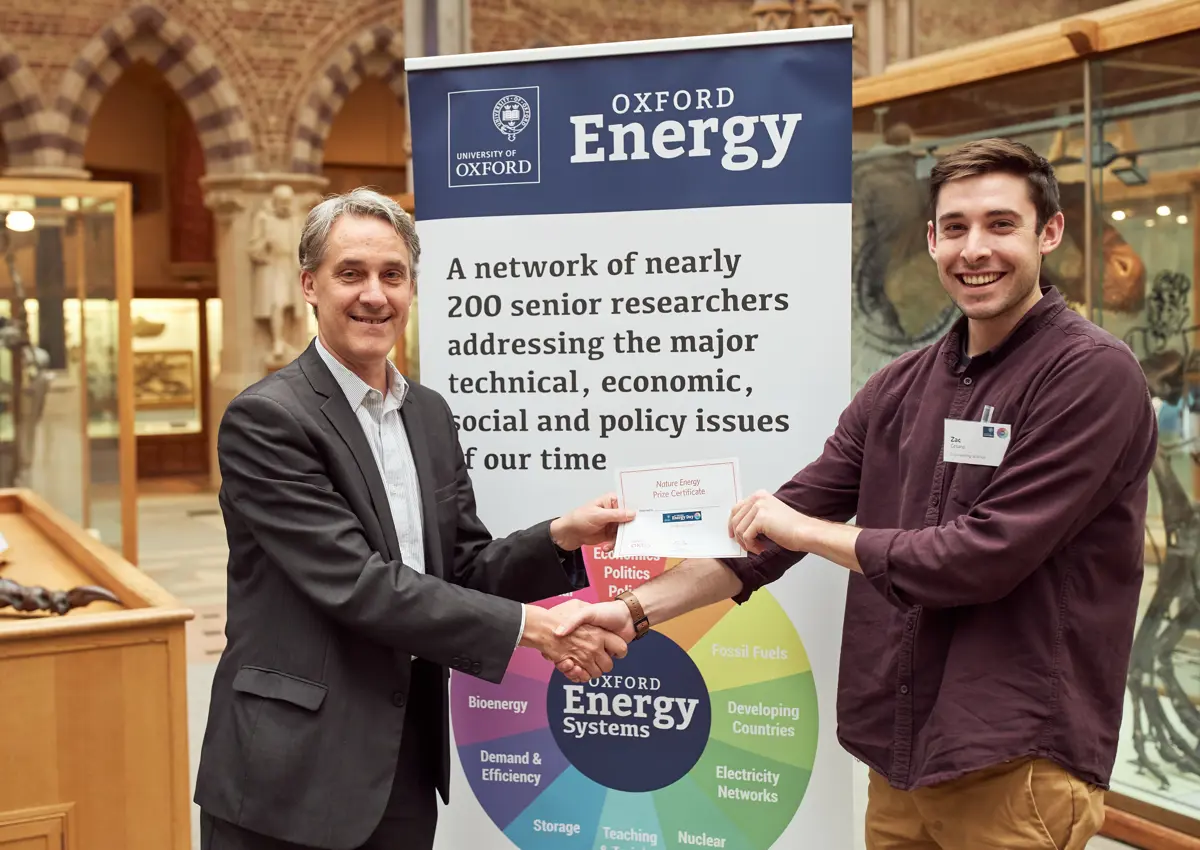25 Oct 2019
The solution to green energy concerns could be in your household cleaning products
So called ‘green ammonia’ could allow the storage and transportation of sustainable energy around the globe. Meet the DPhil candidate investigating applications in developing countries.

One of the advantages of fuels such as oil and natural gas is the ease with which we can store and transport them. Poured into containers and shipped to power plants in every corner of the planet, they can be burned when and where we need them. It isn’t quite as easy with renewable power: what happens when the wind isn’t blowing, or the sun isn’t shining?
One promising solution to the problem is ammonia, a compound of nitrogen and hydrogen currently used as the basis for fertilisers and many household cleaning products. Highly energy-dense, possessing similar storage and transportation characteristics to fossil fuels, but without the harmful greenhouse gasses they produce, and fast achieving economic competitiveness with fossil fuels, ammonia could be the answer to our sustainable energy dilemma.
However, the process of creating ammonia does itself result in a significant release of greenhouse gasses – adding up to as much as 1% of global emissions. Currently, industrial production of ammonia requires splitting the hydrogen out from fossil fuels (whilst nitrogen is obtained from the air). The promise of ‘green’ ammonia is that we could use electricity to split the hydrogen out from water.
That’s the idea behind a £1.5m proof-of-concept plant which Siemens has launched at Rutherford Appleton Laboratory in Oxfordshire in collaboration with STFC, the University of Oxford, and Cardiff University. Zac Cesaro, a DPhil student at the Department of Engineering Science, explains: “I work with Siemens R&D as an operator of the world's first roundtrip green ammonia plant, commissioned in June 2018 as a demonstration of green ammonia for energy storage (Power-to-Ammonia-to-Power).”
“In my DPhil,” he says, “I focus on applying green ammonia technology to developing countries, and my first project has involved modelling the Indian electricity sector to 2040. Green ammonia is a very scalable green energy technology, and thus is highly relevant for countries that are planning to build large amounts of energy infrastructure in the next 20 years – for example, developing countries.”
Zac works under the supervision of Dr. René Bañares-Alcántara, who has been studying the production and applications of green ammonia for the last five years.

Zac recieves his award from Professor Nick Eyre at the Oxford Energy Day
A big vote of confidence in Zac’s research came at Hong Kong Baptist University’s 2019 Entrepreneurship Bootcamp, when he was chosen as Team Leader to head top 3 winning team ‘Emerald Stream: A Green Ammonia Tech Company’.
He explains: “At the Bootcamp, I led a team of graduate and undergraduate students from Oxford, University of California Berkeley, Hong Kong Baptist University, and South China University of Technology to generate a business idea and pitch to investors. Our team was one of the top three teams selected to gain access to funding to pursue our idea of commercialising technology for more cost competitive green ammonia production.”
The team has gained entry to apply for the Hong Kong Science Park’s Science and Technology Entrepreneur Programme, with a seed fund of HK$100,000, and the Technology Start-up Support Scheme for Universities 2020 Final Assessment with a seed fund of up to HK$1.5m. For now, the green ammonia technology, developed by Dr. Edman Tsang and his researchers in Oxford Department of Chemistry, is being scaled from lab bench to a prototype, with an eye on commercialisation via these competitions in the near-term future.
Further success came at the 8th annual Oxford Energy Day conference, which took place at the Oxford University Museum of Natural History in October. Zac was awarded the Best Poster Award for his submission, ‘Green Ammonia: From the Siemens Demonstrator to a Global Energy Infrastructure.’
He adds: “I think that both of these awards demonstrate the growing awareness of climate change and the urgent need for scalable, affordable, green energy technologies. These awards are coming from different places – business and academic environments, east and west – but the unifying message is that green ammonia is a mature technology which could disrupt energy systems around the world.
“I am so grateful for the support and I am excited to continue spreading the word about green ammonia.”



